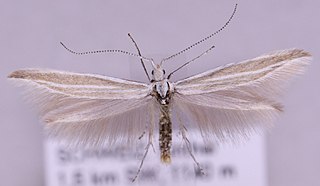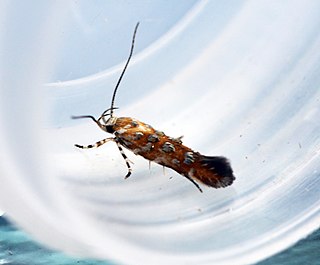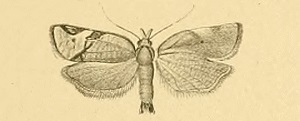
Globularia is a genus of about 22 species of flowering plants in the family Plantaginaceae, native to central and southern Europe, Macaronesia, northwest Africa and southwest Asia. They are dense low evergreen mat-forming perennials or subshrubs, with leathery oval leaves 1–10 cm long. The flowers are produced in dense inflorescences (capitula) held above the plant on a 1–30 cm tall stem; the capitula is 1–3 cm in diameter, with numerous tightly packed purple, violet, pink or white flowers.
The Cosmopterigidae are a family of insects in the order Lepidoptera. These are small moths with narrow wings whose tiny larvae feed internally on the leaves, seeds and stems of their host plants. About 1500 species are described. The taxonomic family is most diverse in the Australian and Pacific region with about 780 species.

Eteobalea is a genus of moths in the family Cosmopterigidae. It is treated as a synonym of Stagmatophora by some authors.
Trifurcula globulariae is a moth of the family Nepticulidae. First described by Klimesch in 1975, it is only known from North Macedonia.
Trifurcula salicinae is a moth of the family Nepticulidae. It is endemic to the Canary Islands.

Jordanita globulariae, also known as the scarce forester, is a day-flying moth of the family Zygaenidae.

Coleophora rectilineella is a moth of the family Coleophoridae. It is found from France and Italy to Romania.
Eteobalea alypella is a moth in the family Cosmopterigidae. It is found in Spain, France, Italy and Morocco.

Eteobalea anonymella is a moth in the family Cosmopterigidae. It is found in most of Europe, except the Benelux, Great Britain, Ireland, Iceland, Norway and Denmark.
Eteobalea beata is a moth in the family Cosmopterigidae. It is found in France, Spain, Portugal, Italy, Romania, Russia and Turkey.
Eteobalea dohrnii is a moth in the family Cosmopterigidae. It is found in France, Spain, Portugal, Italy, Sardinia, Corsica, Sicily, Malta, Croatia, Greece, Crete and Cyprus. In the east, the range extends to Syria.

Eteobalea isabellella is a moth in the family Cosmopterigidae. It is found in Spain, France, Italy, Corsica, the Balkan Peninsula, Turkey and North Africa.
Eteobalea serratella is a moth in the family Cosmopterigidae. It is found in most of Europe, except the Benelux, Great Britain, Ireland, Iceland, Fennoscandia and the Baltic states. It was approved for release in the United States in 1995 for the biological control of toadflax. A few field releases have been made in western Canada and the western United States, but no established populations have been confirmed.
Eteobalea siciliae is a moth in the family Cosmopterigidae. It is found on Sicily, as well as in Algeria and Turkey.
Eteobalea teucrii is a moth in the family Cosmopterigidae. It is found in Spain and Morocco. Moths in this family are often referred to as "cosmet moths" due to their small size and beautiful patterns on their wings.
Eteobalea tririvella is a moth in the family Cosmopterigidae. It is found in France, Italy, Austria, the Czech Republic, Slovakia, Hungary, Croatia, Romania, Moldova, Ukraine, Russia, Mongolia, Latvia, Estonia, Finland and Sweden.

Ancylosis cinnamomella is a species of snout moth in the genus Ancylosis. It was described by Philogène Auguste Joseph Duponchel, in 1836. It is found in most of Europe.

Globularia cordifolia, the heart-leaved globe daisy, is a species of flowering plant in the family Plantaginaceae, native to the mountains of central and southern Europe, and western Turkey.
Nothris lemniscellus is a moth of the family Gelechiidae. It was described by Philipp Christoph Zeller in 1839. It is found from Fennoscandia to the Pyrenees, Italy and Albania, and from France to Ukraine.

Choristoneura simonyi is a species of moth of the family Tortricidae. It is found on the Canary Islands.









